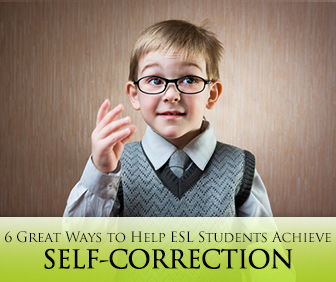6 Great Ways to Help ESL Students Achieve Self-Correction


The natural answer would be, “I'd correct the mistake”. Many agree that as teachers we are trained and programmed to seek out errors and destroy them. We listen to our students carefully and screen through their words to find mistakes that need to be corrected. Though I'm sure none would argue that corrections are necessary, should we correct our students' every mistake, all the time, no matter when that mistake is produced? I guess this is the real question, isn't it? The truth is, corrections can be a little tricky because if they are not done at the right time and in the right way we risk affecting out students' motivation. With this in mind, we can say that we do in fact need to correct but we need to think about when and how.

When we have just introduced new material to students, as teachers our participation is greater at this stage. Our main interest here is for our students to learn the new words, verb tenses, expressions or whatever it is you are teaching. Needless to say, it is extremely important for them to incorporate everything correctly. Corrections here are vital and should be done clearly making sure that when you are done correcting your students are in fact able to use everything as they should. Everything and anything that is not right should be corrected. The correction techniques you can use at this point tend to be simple since your main interest lies in making your students understand what is correct, what isn't, and if their level allows it, why.
Repetition
This is a very simple yet effective technique for beginners. The teacher lets the student know what is correct and asks them to repeat. Look at the example.
S: This is John. He have a cat.
T: OK, let's try again. This is John. He has a cat. Can you say that again, please?
Using visual aids
This one is great for all levels. The teacher uses a visual aid to help student with new material. You can use poster board or even the white board would do. The teacher can simply point to the information that has previously been written down to help students realize what was wrong.
S: Every morning I have coffee and checks my e-mail.
T: OK, let's try one more time (pointing to visual aids with the info).
At this point teachers can give their students more control over what they say and how they say it. Students are more capable of making choices and they can do this during corrections too. Here self-correction is a popular choice since students become more involved in their choices and how to improve them. Take a look at some great techniques you can use for self-correction.
Indicate there is an error without specifying what or where it is
S: My car have four wheels.
T: Let's try that again.
S: My car has four wheels.
Repeat the sentence up to the point the error was made
S: I didn't went to the market.
T: OK let's try again, I didn't …
S: I didn't go to the market.
Repeat the question putting emphasis on the part you want your students to pay attention to
T: Are you going to work tomorrow?
S: Yes I do.
T: Are you going to work tomorrow?
S: Yes I am.
Student initiative activities are those that focus on fluency. We want our students to use what they have learned freely and our participation should ideally be kept to a minimum at this stage of the lesson. This is where they show us what they remember and what they can use without our interference. Naturally, we can expect a lot of mistakes at this point, but we should keep in mind not all of them should be corrected the same way since not all mistakes are the same. There are target errors, the ones students make that are specific to the lesson goals, and there are non-target errors, the ones made with other language not specific to lesson goals. Both should be corrected but we need to spend more time on target errors. There is one more thing to consider. During fluency based activities the main objective is for students to communicate, use the language and make choices on their own. This is why it is recommendable to wait until after the activity is finished to provide needed corrections. You should write down all mistakes made by students on a piece of paper and when they are finished you can use any technique to correct them.
Everyone can learn from mistakes as James Joyce said, “A man's mistakes are his portals of discovery”.